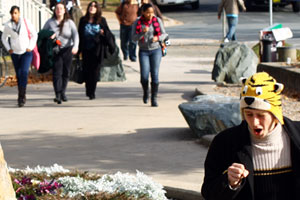 |
| Population models provide insight into the spread of disease from one person to another. (Bruce Bottomley Photo) |
Population ecology is a field that studies population size, growth rates and the variables affecting them. One aspect of this is disease dynamics: the study of the effects of diseases on populations, and of how diseases spread. Disease dynamics is directly relevant to the spread of the H1N1 influenza in humans.
Population models can provide insight in to the dynamics of disease spread, allowing for more effective control. Using estimates of the transmission rate, modellers can project how many people are at risk. This is important for understanding the spread of the H1N1 flu, in order to determine how fast it is spreading and who is at risk.
Ecologists study the dynamics of diseases using “SIR” models, which divide the population into three classes: susceptible (S), infected (I), and recovered (R). The key parameter in an SIR model is R0, the basic reproductive number for the disease. Simply put, R0 is the number of new infections caused by a single infected individual. If R0 is greater than 1, the number of infected individuals increases and the disease spreads; if R0 is less than 1 the number of infections decreases and so does the incidence of the disease.
Transmission rates
Another important parameter in an SIR model is “β,” the transmission rate of the disease. Think of β as the probability that an encounter between an infected and a susceptible individual will result in a new infection. R0 is calculated by multiplying β by the number of susceptible individuals (S) and the average duration of the time an individual is infective. The key point is that R0 can be greater than 1 only if a minimum number of susceptible individuals are present in the population. The goal of vaccination programs is to move enough individuals out of the susceptible class and into the immune class so that R0 is reduced to less than 1, causing the incidence of the disease to shrink.
Estimates of R0 for H1N1 vary between 1.2 and 1.7, though some countries report even higher and lower figures. The Canadian estimate of R0 is 1.5. To give you a point of reference for this value, the seasonal flu has an R0 of 1.2 - 1.4, SARS 3 and the measles 7.1. The proportion of the population that must be immunized in order to eradicate the disease varies depending on R0, and is calculated with the formula 1-(1/R0).The proportion of the population that must be immunized when R0 is 1.5 is 33 per cent.
Vaccinations are one way of achieving the necessary proportion of immunized individuals in a population. However, vaccinating a proportion of the population equal to the calculated proportion that must be immunized may not be enough. One reason for this is the effectiveness of the vaccine. If the vaccine does not give immunity to 100 per cent of recipients, the proportion of the population that needs to receive the vaccine would have to be higher than the calculated proportion. Basically, this means more people would have to get the vaccine because not everyone who has received it is immune. The current vaccine for H1N1 has been shown to leave 10 to 30 per cent (Feng and Towers, 2009) of vaccinated individuals still at risk for the virus.
Time to achieve immunity
Another factor to consider is the time needed to achieve immunity. After receiving the vaccine, the body’s full immune response takes two to 10 days to occur in adults and up to four weeks in children (Feng and Towers, 2009). This means there is a window of time when, despite vaccination, a person is still at risk for contracting H1N1.
There are factors that also work to lower the number of people that need to be vaccinated. Some individuals in the general population who have had neither H1N1 nor the vaccine still express immunity, because they have been exposed to similar flu strains in the past. Most of these individuals are 60 years or older and add to the proportion of immunized people in our population (CDC, 2009). Other factors affect the spread as well, such as cleanliness and population density, which change transmission rate, and hence R0.
The current immunization campaign is focusing on protecting people who are most susceptible to complications from having H1N1, such as young children and pregnant women. With the virus already spreading quickly, the vaccination program is unlikely to have a big effect on the spread of H1N1 – R0 is unlikely to be lowered below 1 – but the most vulnerable can be protected. Getting vaccinated against the current version of H1N1 may also provide at least partial immunity to any new strains of the virus that appear later. This is a good thing, because disease models predict that the more people are immune, the less likely that new strain is to spread and reach pandemic status.
ĚýĚýĚýTowers S, Feng Z. Pandemic H1N1 influenza: predicting the course of a pandemic and assessing the efficacy of the planned vaccination program in the United States. Euro Surveill. 2009;14(41):pii=19358. Available online:
ĚýĚýĚýCenters for Disease Control and Prevention (CDC) (2009). Serum cross-reactive antibody response to a novel influenza A (H1N1) virus after vaccination with seasonal influenza vaccine. MMWR. Morbidity and mortality weekly report, 58 (19), 521-4 PMID
Also received information from the 811 Health Link Service. They provided the 2 to 10 day estimate for the vaccine to become effective in adults.
Ěý
Prepared by students David Blanchard, Leigha MacKay, Anita Nipen, and Hillary Wainwright, with some gentle editing by Julie Sircom.
